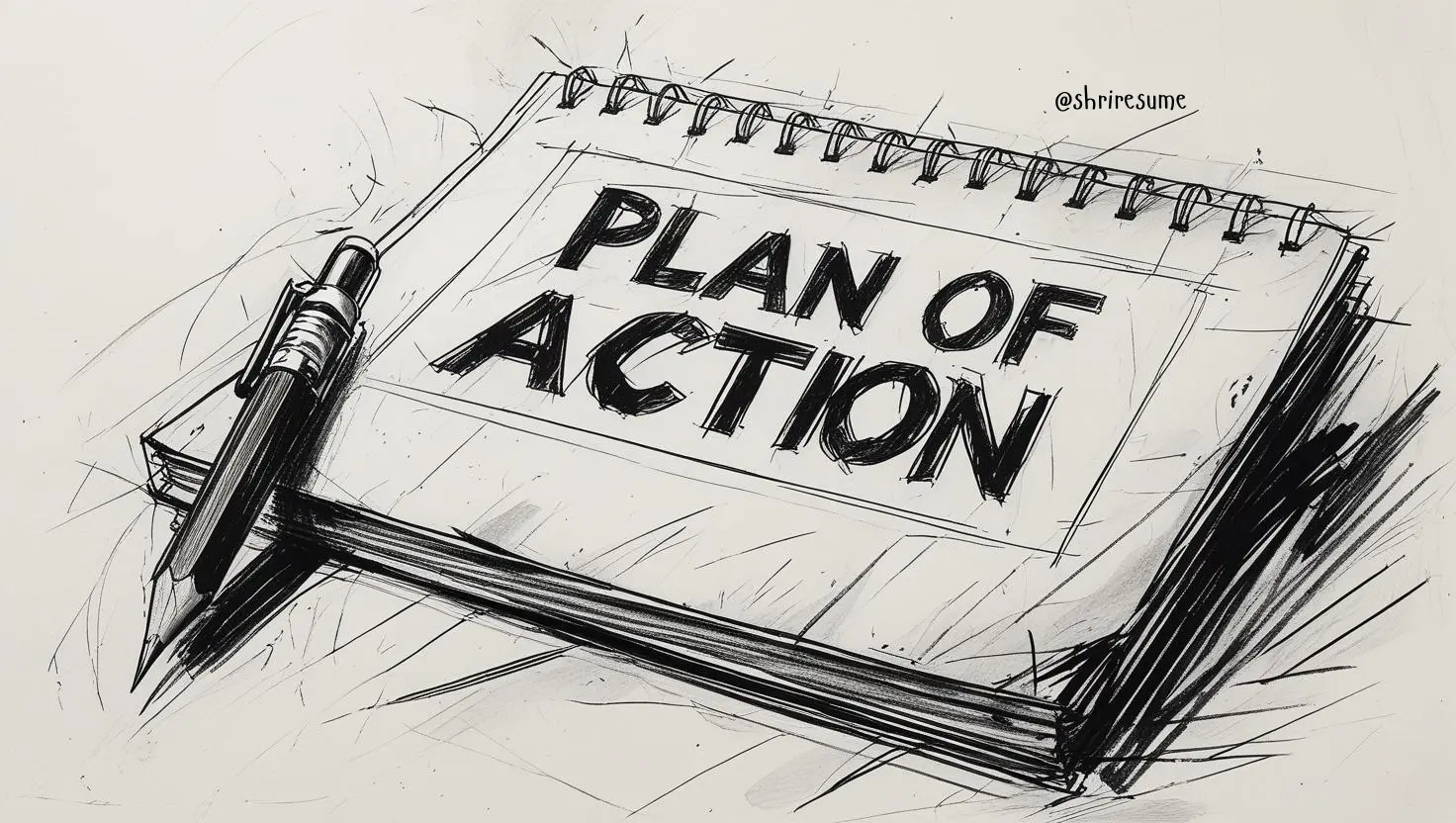Your Plan of Action for Job Change or Finding Your First Job
Looking for a job can be a daunting task, regardless of what you are planning for; a new job or a job change. While some fortunate job seekers manage to grab a job without putting in much effort, the cold truth is that most of us aren’t that lucky!

Having said that, it doesn’t mean that you should wait for fortune to smile on you. Instead, you should strive to create your own destiny. In simple terms, you should capitalize on what you possess and create a proper job search action plan to boost your chances of getting your dream job. So, let’s first understand what a job search action plan is.
Job Search Action Plan - What Is It and Why It Is Important
A plan of action for a job search means creating a strategy that helps a candidate when he/she is actively looking for a new job or job change. A job search plan encompasses all aspects of a job search – from choosing relevant work experience and customizing a resumeto keeping a tab on job boards and preparing for common interview questions.
Inclusions of a Job Search Action Plan
A job search action plan comprises a number of steps with each focusing on different facets of the job hunt process. These steps should be arranged chronologically, around which you will build your day-to-day as well as weekly schedule.
You may also be required to assign daily and weekly targets, just to see when to perform a particular task or a set of tasks. Setting deadlines also helps you monitor your progress. The tasks to be performed when following a job search action plan may vary from person to person, but every plan has common stages that should essentially be there if you truly want to get into your preferred role.
Stages of a Job Search Action Plan
Each stage consists of a specific action or an array of related actions that serve a common purpose, aimed at improving your chances of bagging your target job.
Stage 1: Question Your Decision
Do You Really Want a Change?
Before you take any step, it is important to ensure that you really want a new job or it’s just you had a bad experience at the office yesterday. A job change is a momentous decision, so if you are on the horns of a dilemma, you should prepare a checklist of your priorities and re-analyze the reasons behind your job change decision.
Is This the Right Time?

Another important point is to see if it is the right time for you to change the job. Is your promotion due at your present organization? Do you have an important project to oversee at your office or something personal that may impact your job hunt process? Remember that your partial dedication is likely to bring no positive outcome to you, which would eventually lower your confidence level.
What Do You Expect From the New Job?
A job seeker has myriads of things to consider before looking for a change. It could be the size of the company, pay office hours, industry type, fringe benefits, and so on. Thus, before you begin applying, figure out what exactly you want from your next role as this will help you land a job best suited to your requirements.
Stage 2: Acquiring the Right Skills
Finding Skills that You Need:
You should identify in advance the skills that your target industry or companies generally look for in potential job candidates. Plus, think about how you can be a good match for your dream job, i.e., whether you have the appropriate qualification, work experience, or skill set required for that job.
Applying for Some Work Experience:
If you are a fresh graduate or looking for a career change, it is a great idea to get some work experience in the field of your interest. This will help recruiters to consider you as a potential candidate for that particular position. You can also consider job shadowing and volunteering opportunities that can land you a job.
Stage 3: Getting Your Application Ready
You can start engaging in your social media account and create some relevant contents that are relevant to your job position. This will help the employer to know how creative and potential you are for the job position.
Note: Change your privacy settings to those posts that are irrelevant to your position and may disappoint your prospective employer.
Mention your social media account details along with your contact details in your resume. You can pen down the date of the application, the deadline of the application when to follow up with your employer, the application status, and so on. If your application is rejected, request feedback, so that you can note it in your tracker and not repeat any mistakes next time
Customizing Your Resume:
Now that you know which skills you have to acquire or you already possess, it’s time to put them down on your resume. List your educational details, work experience, and skills while covering other major sections of a resume as per the jobs you are applying for. Here, your attention should be on making an impressive resume while focusing on the roles of your interest.
Creating a Cover Letter:
Writing an imposing cover letter is crucial since prior to taking your resume in hand, the recruiter will read your cover letter – something which will be read for only 20 seconds, but still decide whether your resume is worth considering or not! Thus, just like your resume, your cover letter to has to be tailor-made.
Updating LinkedIn Profile:
Nowadays, networking can significantly help you get your target job. Once you have customized your resume and cover letter, update your profile on LinkedIn in accordance with both. Recruiters of today are most likely to visit your LinkedIn page – maybe to see if everything matches with what is there on your resume or cover letter!
Identifying Your Source:
Now that you have that perfect CV , cover letter, and social media pages, it’s time to begin searching for your dream job. Undoubtedly, job boards will remain your primary source as they simply help your search by refining your results with job titles, relevant keywords, industry types, and locations. It is good to sign up for job alerts as job posts get updated every 24 hours. Nevertheless, you can also try some untapped and lesser-known networking opportunities that can actually help you land a job.
Following Up:
Maintaining your patience is the key, yet there is nothing wrong with following up to check whether your employer has received your job application or not. This shows your enthusiasm but remembers not to overdo it.
Monitoring the Progress:
Applying for multiple job openings is a good option but can be tough for you to keep track of the progress of each application. So, to keep track of all the resumes you can develop a tracker over a spreadsheet or Note Pad to help you monitor everything easily.
Stage 4: Preparing for Interviews
Preparing for a Telephonic Interview
Many employers prefer conducting a telephonic interview and you may also be invited for the same. If so, start prepping to ace the telephonic interview.
Readying for a Face-to-Face Interview:
A telephonic interview is somewhat similar to a face-to-face interview. The only difference is that the latter can be a bit more stressful. You can follow some proven tips and read about common interview questions to sail through a personal job interview.
Choosing the Right Attire:

There is a thin line difference between dressing up just formally and going overboard with it. So, choose what you will wear on your big day sensibly.
Deciding the Next Step:
Once the interview gets over, never forget to follow up with the employer and thank him/her for the opportunity offered to you. Thereafter, all you can do is to wait for the response – either an invitation for the next/final phase, an offer letter, or rejection. If you are selected then it’s well and fine, but if you are rejected then remember that you have an ample number of opportunities lined up. So don’t get upset and learn from the feedback/mistakes and start prepping for the next.
Stage 5: Accepting an Opportunity
Having a Reference:
If you have made it through the interview and received an offer for the job of your dream, you may need two or three references from your present and (maybe) past employers. Select people who you personally know and are able to explain your skills and expertise relevant to the job.
Executing Your Job Search Action Plan
It’s totally up to you how you create your timeline for implementing your job search action plan. It may take several days to a few weeks to submit your job application and get your interviews scheduled.
Experts suggest splitting the whole time into small parts – each dedicated to a specific set of tasks – to keep yourself motivated throughout the job search phase. Also, make sure that you concentrate more on the quality of your applications rather than creating a huge pile of substandard ones. Applying for four to five jobs a day is more than enough. If you want 24\*7 updates on job boards, then subscribe to job alerts to have job posts directly in your inbox. Besides, you shouldn’t keep all your hopes on a single job. To increase your chances of getting a job as soon as possible, apply for multiple positions at the same time.
Get a higher quality resume format
Our Resume Builder ensures best practices, logic, formatting standards and job matching opportunities from thousands of job boards and portals around the world.
By clicking Start Your Resume, Your are agree to our Terms of use and Privacy Policy
 India's
premier resume service
India's
premier resume service






